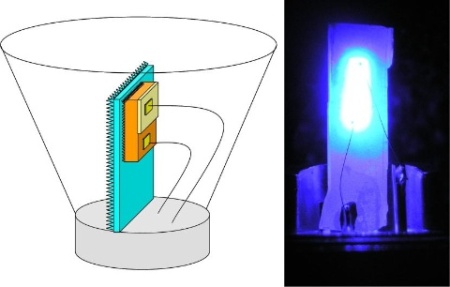Researchers from Japan and California have developed a new design for blue and green LEDs to reduce efficiency droop. The observations will be demonstrated during the Conference on Lasers and Electro-Optics (CLEO: 2012), scheduled from May 6 to 11 in San Jose, California.
 Schematic of the transparent LED packaging design (left). A working blue LED using the design (right). (Photo: Yuji Zhao, University of California Santa Barbara)
Schematic of the transparent LED packaging design (left). A working blue LED using the design (right). (Photo: Yuji Zhao, University of California Santa Barbara)
The research team designed low droop and high efficacy LEDs by altering the direction of the crystal structure within semiconductor films. Droop refers to significant drop in efficiency at extreme currents. It is one of the major factors that retard the growth of the solid-state lighting market.
Household bulbs generate white light due to the mix of wavelengths with the hue produced from blue and green LEDs. These valuable colors are the ‘droopiest’ of the LEDs and are difficult to design.
LEDs have increased energy-efficiency compared to the heat-generating incandescent bulbs. However, the LEDs lose a major part of this efficiency at high current lighting due to the droop feature. Although the droop-causing factor has not been clearly resolved, the research team at UC Santa Barbara has devised an innovative technique to reduce droop by revolutionizing the production method of LEDs.
LED chips are created from layers of doped semiconductors packed together. By applying voltage through these layers, migration of electrons and holes takes place, which is directed toward an active layer area of LED, resulting in a photon. The commercially available blue LEDs, the c-plane accommodate the crystals that bind the semiconductor layers. Based on this standard orientation of the crystals, electrical fields that intervene during integration of the electrons and holes can be created.
The research team from UCSB designed LEDs that consist of tilted and non-traditional crystal orientations that reduce the field’s effect, showing minimal droop. Based on this approach, compact and low-cost LED chips were developed by the researchers.